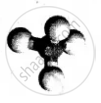Advertisements
Advertisements
प्रश्न
Differentiate between the following with suitable examples- A basic radical and an acid radical
उत्तर
The positive part is called the basic radical and the negative part is called the acid radical.
A compound maybe consider having –
- A positive part [e.g. metal or ammonium ion]
- A negative part [e.g. chloride, bromide, sulphate, nitrate etc.]
| Compound | Positive part - Basic Radical | Negative part - Acid radical |
| Sodium | \[\ce{Na+}\] | \[\ce{NO3-}\] |
| Ammonium | \[\ce{NH4+}\] | `"SO"_4^--` |
| Sulphate |
\[\begin{bmatrix} |
|
|
|
APPEARS IN
संबंधित प्रश्न
Calculate the number of aluminium ions present in 0.051 g of aluminium oxide.
(Hint: The mass of an ion is the same as that of an atom of the same element. Atomic mass of Al = 27 u)
Write the names of `"H"_2"S"` compounds :
Define ‘formula mass’ of a compound.
Fill in the following blank with suitable word:
A potassium ion has positive charge because it contains less............... than.....................
The valencies (or charges) of some of the ions are given below :
| Ion | Valency (Charge) | Ion | Valency (Charge) |
| Sodium ion | 1+ | Bromide ion | 1– |
| Ammonium ion | 1+ | Hydroxide ion | 1– |
| Calcium ion | 2+ | Sulphate ion | 2– |
| Lead ion | 2+ | Phosphate ion | 3– |
Using this information, write down the formulae of the following compounds :
(i) Sodium phosphate
(ii) Ammonium sulphate
(iii) Calcium hydroxide
(iv) Lead bromide
Give example.
Positive radicals
Write the basic radicals and acidic radicals of the following and then write the chemical formulae of these compound.
Chromium sulphate
State if the following element or radical is divalent?
Sulphite
State if the following element or radical is divalent?
Carbide
State if the following element or radical is divalent?
Permanganate

